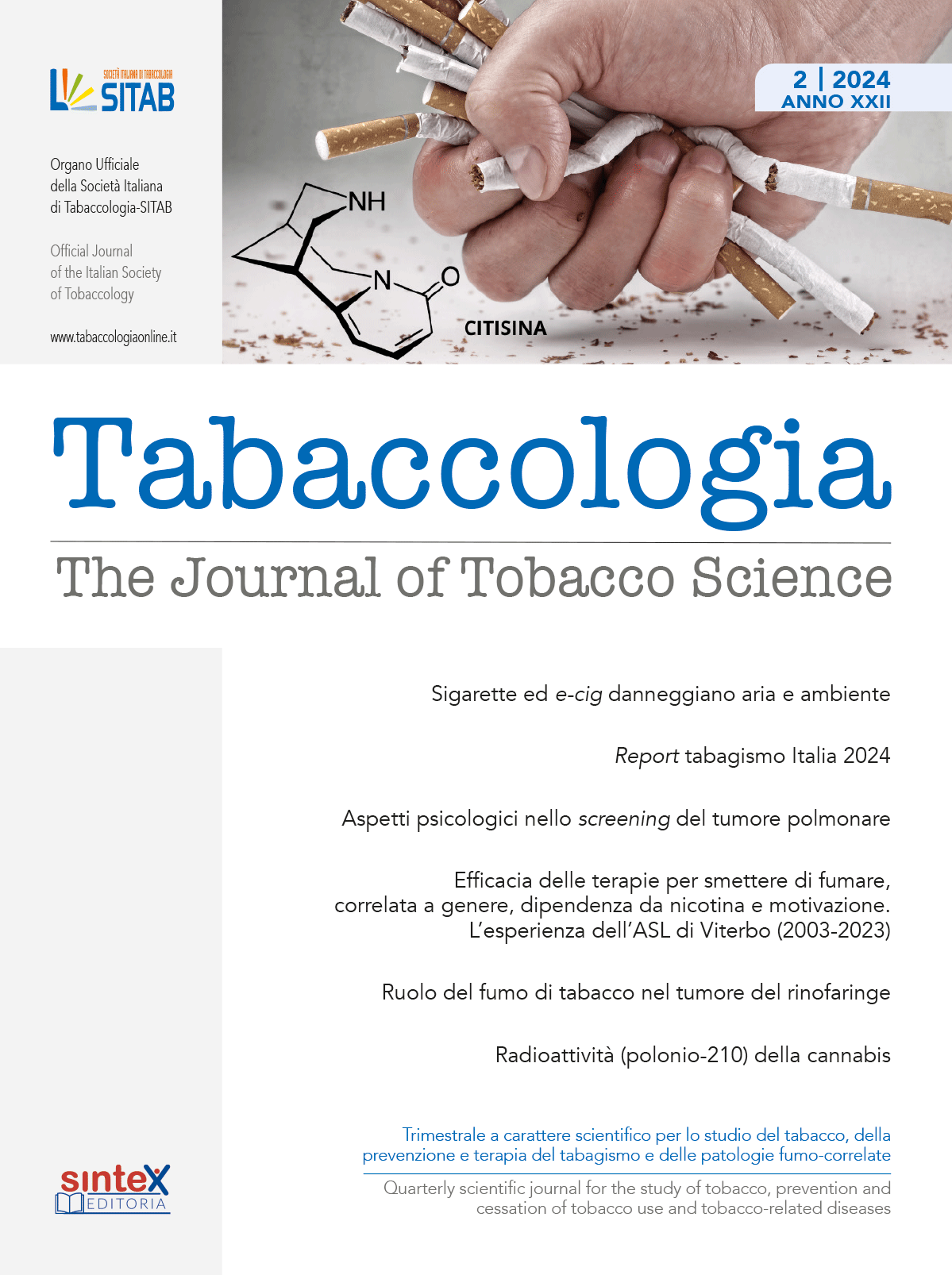|
Rassegna Stampa Scientifica Aprile 2024
|
“Atlantic City casino workers have tried unsuccessfully for years to persuade New Jersey lawmakers to outlaw smoking on gambling floors. [Last] Friday morning, they took their efforts to court. In a lawsuit filed in State Superior Court in Mercer County, groups representing thousands of casino employees accused state legislators of giving special treatment to casino owners by allowing them to let people smoke inside their facilities. The state has allowed casinos to “knowingly force employees to work in toxic conditions,” the workers argued in court documents, and as a result, casino workers have experienced “life-threatening illness and death.”” [Erin Nolan. You Can Still Smoke in Atlantic City Casinos. Workers Want to Ban It, New York Times. Ed. Note: See below for two SHS papers by James Repace.]
“The American College of Cardiology has some bad news for e-cigarette users after a new study found that those who vape are 19% more likely to develop heart failure compared to their non-vaping counterparts. Researchers used data from a National Institutes of Health (NIH) study, including surveys and electronic health records, to assess potential correlations between heart failure diagnoses and e-cigarette use in over 175,000 patients… Marketing campaigns for vaping have appealed to younger audiences in recent years, touting flavors like cotton candy, marshmallow and bubble gum to entice potential buyers, similar to decades-long advertisements. Over the years, though, advertisements for traditional cigarettes have dwindled as experts have increasingly sounded the alarm over their potential side effects.” [Taylor Penley. Smoking cigarettes can destroy lungs, but shocking new study reveals why vaping can harm the heart, Fox News. See also: Study Links E-Cigarette Use with Higher Risk of Heart Failure, American College of Cardiology]
“A Go Smoke Free spokesman said: …“The new disposable vape ban should help to discourage children from taking up vaping, while encouraging adults to shift to more sustainable alternatives, such as refillable vapes.”… Ministers are seeking to draw up measures which will stop children from taking up the habit, while ensuring that they do not deter the use of e-cigarettes as a route to quit smoking… A Cancer Research UK study found that between January 2021 to August 2023, the prevalence of disposable e-cigarette use grew from 0.1 per cent to 4.9 per cent of the adult population. The proportion of those aged 18 to 24 using disposable vapes was significantly higher at 14.4 per cent, including 7.1 per cent who did not have a history of smoking tobacco.” [Alex Barton. The town named the vape shop capital of the UK, The Telegraph]
“A leading medical information company has been urged to cancel a series of new education courses on smoking cessation funded by the tobacco industry giant Philip Morris International (PMI). Physicians and academics have rounded on Medscape for partnering with PMI on five courses launched in the past few months, and they have called for stricter oversight by certification bodies. Anna Gilmore, professor of public health and director of the Tobacco Control Research Group at the University of Bath, UK, said that Medscape had “now lost all credibility and has some serious questions to answer. PMI lost all credibility decades ago, despite its ceaseless and highly misleading attempts to rehabilitate its image. It has now sunk to a new low.” Medscape has temporarily taken down some of the courses while it carries out a review, but it told The BMJ that it had so far “found no evidence of deviation from Medscape’s strict quality and integrity standards.”…
““The support for the use of smokeless tobacco products and e-cigarettes in the content aligns with the corporate objectives of Philip Morris International,” [Pamela Ling, director of the Center for Tobacco Control Research and Education at the University of California San Francisco] said. “The tobacco industry has an exceedingly well documented history of denying and distorting scientific evidence, and it has no place in medical education… Robert Jackler, Sewall professor emeritus at the Stanford University School of Medicine in California, said, “I’ve been a physician for over 40 years. I don’t ever remember the tobacco industry sponsoring . . . certified physician education.”… He highlighted a slide of the courses that stated, “The health goal for all smokers should be smoke free, not tobacco/nicotine abstinent.” Jackler commented, “Only purveyors of tobacco products would make such a ridiculous assertion. The health goal is not switching to another PMI product line but rather to break nicotine addiction and thus halt all use of tobacco products.””
BMJ Investigation
Exclusive: Outcry as Philip Morris International funds smoking cessation courses on Medscape
BMJ 2024;385:q830 (Published 09 April 2024)
Hristio Boytchev
https://www.bmj.com/content/385/bmj.q830
https://www.bmj.com/content/bmj/385/bmj.q830.full.pdf
Note: Open Access.
“To date, 66 countries have implemented what are considered best-practice TAPS [tobacco advertising, promotion and sponsorship] bans, protecting almost 2 billion people and, according to Andrew Black, team leader for development assistance at the WHO FCTC Secretariat, they have significantly decreased smoking uptake and prevalence, particularly among young people. Unfortunately, as digital media content and the platforms designed to support their dissemination have continued to evolve, tobacco companies and other nicotine purveyors have found ways to get round the bans, notably by using social media platforms.
““Many of the bigger social media platforms and search engines have banned direct promotion, but tobacco companies have just slipped below the surface,” says [University of Sydney Professor Becky] Freeman. “For example, they might use Facebook web pages featuring ‘lifestyle’ content that seeks to normalize tobacco and nicotine consumption by depicting young people smoking or vaping.”… For Freeman, regulatory tightening cannot come too soon. “There has been this narrative that nothing can be done,” she says. “But there is a lot that government can do, as we have shown in Australia.””
Editorial
Countering the influence of tobacco
Bull World Health Organ. 2024 Apr 1; 102(4): 230–231.
Published online 2024 Apr 1.
https://www.ncbi.nlm.nih.gov/pmc/articles/PMC10976864/
https://www.ncbi.nlm.nih.gov/pmc/articles/PMC10976864/pdf/BLT.24.020424.pdf
Note: Open Access.
“The study was a cross-sectional descriptive analysis of tobacco expenditure from the Smoking Toolkit Study (STS) matched to income and smoking prevalence data for English local authorities… The total dividend in England is estimated to be £10.9 billion each year, which equates to £1776 per person who smokes or £246 per adult regardless of smoking status… Conclusions This study has estimated that local economies could gain a substantial dividend if everybody stopped smoking, which is larger in lower income areas, meaning that geographical economic inequalities could be reduced… Conclusions: This study has estimated that local economies could gain a substantial dividend if everybody stopped smoking, which is larger in lower income areas, meaning that geographical economic inequalities could be reduced.”
Potential smoke-free dividend across local areas in England: a cross-sectional analysis
Tobacco Control Published Online First: 20 March 2024.
Damon Morris, Duncan Gillespie, Martin J Dockrell, Mark Cook, Marie Horton, Jamie Brown, Tessa Elisabeth Langley
https://tobaccocontrol.bmj.com/content/early/2024/02/05/tc-2023-058264
https://tobaccocontrol.bmj.com/content/tobaccocontrol/early/2024/02/05/tc-2023-058264.full.pdf
Also:
Industry Watch: Marlboro Man goes artisanal?
https://tobaccocontrol.bmj.com/content/early/2024/04/02/tc-2024-058645
https://tobaccocontrol.bmj.com/content/tobaccocontrol/early/2024/04/02/tc-2024-058645.full.pdf
Across the world availability of flavour accessories for tobacco products
https://tobaccocontrol.bmj.com/content/early/2024/04/05/tc-2023-058255
https://tobaccocontrol.bmj.com/content/tobaccocontrol/early/2024/04/05/tc-2023-058255.full.pdf
Note: Open Access.
Related coverage:
Quitting smoking could redirect £11bn a year into local economies, study says
“This study investigates the health problems reported by 162 nonsmoking residents residing in 104 multiunit apartments in 71 municipalities in 19 U.S. States and the District of Columbia, plus 2 Canadian Provinces… Nonsmokers complained of eye, nose, throat, and lung irritation, headache, dizziness, nausea, difficulty in breathing, tachycardia, and asthmatic attacks as well as malodors. Many sought medical care and some were hospitalized. Some regarded their apartments as uninhabitable. About 12% resorted to litigation… Conclusions: Secondhand smoke infiltration from smokers’ apartments into nonsmokers’ apartment units in multiunit housing can provoke major morbidity for nonsmoking residents. Nonsmokers’ efforts to eliminate infiltration by sealing of cracks, air cleaning, or increased ventilation proved futile. Building owners and managers need to be educated about protecting nonsmoking residents’ health and welfare from secondhand smoke infiltration. Smoking of tobacco and marijuana products in multiunit housing should be banned.”
Secondhand smoke Infiltration in multiunit housing: Health effects and nicotine levels
Indoor Environments
Volume 1, Issue 2, June 2024, 100013
Available online 26 March 2024, Version of Record 3 April 2024.
James L. Repace
https://www.sciencedirect.com/science/article/pii/S2950362024000109
Note: Open Access.
“Ms. PJM’s modeled exposure to fine particulate matter from secondhand smoke ranged from the Hazardous to Significant Harm Levels of the EPA Air Quality Index for fine particles (PM2.5). Her modeled dose of serum cotinine ranged from the 90th to beyond the 95th percentile of nonsmokers’ dose, measured in a statistical sample of the U.S. nonsmoking population. Her estimated risk exceeds OSHA’s Significant Risk of Material Impairment of Health Level by a factor of three. She is estimated to have been exposed to the thirdhand smoke of at least 1.4 million cigarettes outgassing from room surfaces during her 20 years of labor… Conclusions: As a result of her occupational exposure to secondhand and thirdhand smoke, Ms. PJM [who had been employed as a motel maid cleaning rooms for 20 years] lost an estimated 33 years of life expectancy. The State of California has been remiss in failing to extend its workplace smoking ban to hotels and motels, leaving their workstaff at grave risk of the manifold diseases of passive smoking.”
Case Report
Forensic Analysis of Lung Cancer from Secondhand Smoke Exposure of a Motel Worker
European Society of Medicine
Vol 12 No 3 (2024): March issue, Vol.12, Issue 3
Published Mar 26, 2024
James L. Repace
https://esmed.org/MRA/mra/article/view/5120
https://esmed.org/MRA/mra/article/view/5120/99193547825
Note: Open Access.
“The study subjects were patients aged ≥20 years undergoing surgery from December 2021 to September 2022 who completed spirometry and reported tobacco (cigarette and HTP [heated tobacco product]) use status during the preoperative assessment… Conclusion: Current HTP use was associated with airway obstruction among patients with cancer who had completely switched from cigarettes even after quitting smoking for a long period. Patients should be routinely screened for HTP use and advised to quit any tobacco.”
Association between heated tobacco product use and airway obstruction: a single-centre observational study, Japan
BMJ Open Respir Res. 2024 Mar 9;11(1):e001793.
Satomi Odani, Shihoko Koyama, Isao Miyashiro, Hironobu Tanigami, Yoshifumi Ohashi, Takahiro Tabuchi
https://bmjopenrespres.bmj.com/content/11/1/e001793.long
https://bmjopenrespres.bmj.com/content/bmjresp/11/1/e001793.full.pdf
Note: Open Access.





















